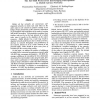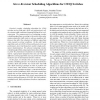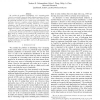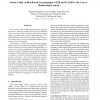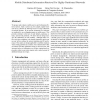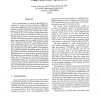ICNP
2003
IEEE
14 years 4 months ago
2003
IEEE
ICNP
2003
IEEE
14 years 4 months ago
2003
IEEE
CAMs are the most popular practical method for implementing packet classification in high performance routers. Their principal drawbacks are high power consumption and inefficient...
ICNP
2003
IEEE
14 years 4 months ago
2003
IEEE
Structured peer-to-peer overlays provide a natural infrastructure for resilient routing via efficient fault detection and precomputation of backup paths. These overlays can respo...
ICNP
2003
IEEE
14 years 4 months ago
2003
IEEE
TCP performs poorly on paths that reorder packets significantly, where it misinterprets out-of-order delivery as packet loss. The sender responds with a fast retransmit though no...
ICNP
2003
IEEE
14 years 4 months ago
2003
IEEE
Practical crossbar scheduling algorithms for CIOQ switches such as PIM and ¢ -SLIP, can perform poorly under extreme traffic conditions, frequently failing to be workconserving....
ICNP
2003
IEEE
14 years 4 months ago
2003
IEEE
We consider the problem of distributing “live” streaming media content to a potentially large and highly dynamic population of hosts. Peer-to-peer content distribution is attr...
ICNP
2003
IEEE
14 years 4 months ago
2003
IEEE
Peer-to-peer systems enable efficient resource aggregation and are inherently scalable since they do not depend on any centralized authority. However, lack of a centralized autho...
ICNP
2003
IEEE
14 years 4 months ago
2003
IEEE
This paper targets the problem of optimal resource allocation in overlay multicast, which poses both theoretical and practical challenges. Theoretically, resource allocation among...
ICNP
2003
IEEE
14 years 4 months ago
2003
IEEE
We propose and evaluate a mobile, peer-to-peer Information Retrieval system. Such a system can, for example, support medical care in a disaster by allowing access to a large colle...
ICNP
2003
IEEE
14 years 4 months ago
2003
IEEE
